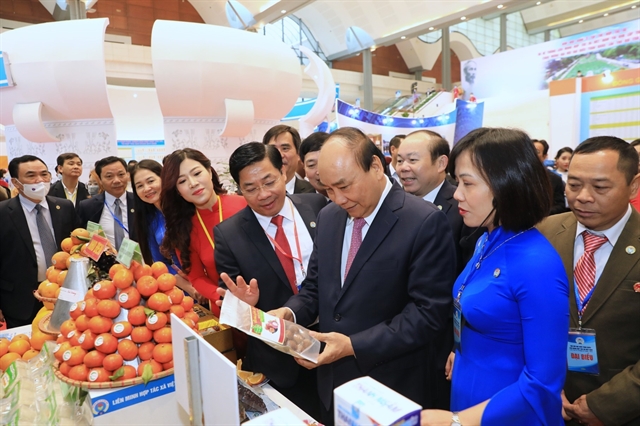 Economy
Economy


|
| Prime Minister Nguyễn Xuân Phúc and other delegates visit an exhibition on development of collective economy and cooperatives as part of activities to celebrate the 6th National Congress of the Vietnam Cooperatives’ Alliance for the 2020-2025 tenure. VNA/VNS Photo Thống Nhất |
HÀ NỘI — Prime Minister Nguyễn Xuân Phúc has asked the Vietnam Cooperative Alliance (VCA) to work closely with authorised agencies to fully exploit the potential of cooperatives, promoting the development of the collective economy and cooperatives through the effective implementation of public services and programmes.
He made the request at the 6th National Congress of the Vietnam Cooperatives’ Alliance for the 2020-2025 tenure held in Hà Nội on Tuesday.
It was necessary to remove difficulties for cooperatives and scale up effective cooperative models.
Phúc said the legal framework relating to the collective economy and cooperatives as well land, tax and credit should be reviewed to create optimal conditions to spur cooperatives’ operations and their members’ creativity.
It was essential to allocate resources to implement the State's preferential policies for the collective economy and cooperatives which is in accordance with the balancing capacity of the state budget and the condition of the country.
Domestic and global experience showed that connecting separate smallholders to form cooperatives and cooperative unions is the best way to improve the livelihoods of the millions of farming households, he said, adding that developing the collective economy must start from people’s demand.
The PM said he was glad to hear a report delivered at the congress that in the 2016-2020 period the collective economy and cooperatives continued to develop in both quantity and quality. By the end of this year, there were 26,040 cooperatives, attracting 8.1 million members.
The number of cooperatives that operate efficiently accounted for 59 per cent of the total number of cooperatives, an increase of three times compared to 2015’s figure while those applying high technology and production associated with the value chain rose by 6.8 times compared to that of 2015.
Collective economy and cooperatives contributed about 4.8 per cent of the country’s Gross Domestic Product.
However, he said, Việt Nam’s cooperative economy potential had not been tapped. The sector’s growth was still low compared with other sectors.
There was uneven development among regions, between agricultural and non-agricultural areas and the linkage between different economic types were still weak, the PM said.
Phúc pointed out that there were shortcomings in the State management of collective economy and cooperatives and some local governments had not paid due attention to the cooperatives’ operations.
The Prime Minister emphasised that "the collective economy and cooperatives are an inevitable trend in integration".
“It is the economic model of the people, by the people and for the people.
“Strong development of the collective economy and cooperatives is to bring into play the strength of great national unity in socio-economic development towards the goal of "rich people, strong democracy, fair and civilized country,” said Phúc.
The VCA’s sixth national congress was attended by 600 official delegates representing about 30 million labourers across the country.
In addition to reviewing VCA’s operations for the 2016-2020 tenure, the Congress also laid out orientations and tasks for 2020-2025.
Income of cooperative member increases by 6 per cent per year and the number of households and individuals becoming members of cooperatives or collective groups rise by 15 per cent. Between 300-500 cooperative models that apply high technology or attach their production to product’s value chains are set up each year.
Cooperatives that operate efficiently in the agricultural sector account for 70 cent. — VNS




